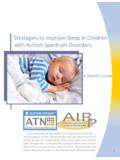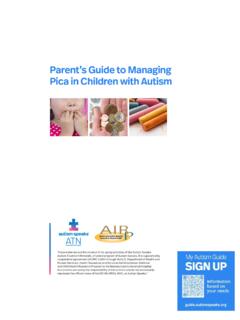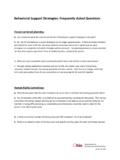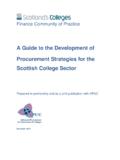Transcription of What are the Positive Strategies for Supporting …
1 What are the Positive Strategies for Supporting Behavior Improvement? As highlighted in the previous section, there are many possible contributors to the development of challenging behaviors. It is important to investigate and evaluate these, but also to take action sooner rather than later, since many behaviors can become increasingly intense and harder to change as time goes on. Often a necessary approach to managing behavior involves a combination of addressing underlying physical or mental health concerns, and using the behavioral and educational supports to teach replacement skills and self-regulation. There is no magic pill, but there are a number of Strategies that can often be helpful. The use of Positive Behavior Supports is more than just a politically correct approach to behavior management. Research shows that it is effective. The alternative is usually punishment, which decreases the likelihood of a behavior by taking something away (such as removing a favorite toy) or doing something unpleasant (yelling, spanking.)
2 While punishment might work immediately, it has been shown to be ineffective in the long run and can increase aggressive behavior, provide a model for additional undesirable behaviors, and strain the relationship with the caregiver (you). It is worth noting that to continue to be effective and maintain improvements, Positive supports and feedback need to be ongoing as well. Withholding reinforcement for problem behavior ( , extinction) is technically an example of punishment. Proponents of Positive Behavior Support (PBS) acknowledge that controlling access to reinforcement is necessary when trying to change behavior. What PBS does not condone is the use of aversive ( , demeaning, painful) procedures to suppress behavior. Such approaches have been demonstrated to be ineffective in producing durable changes in people's behavior and do not improve to quality of their lives. Association for Positive Behavior Support If you have made changes to improve your child's health or happiness, and these have not helped to improve his behavior in a reasonable time frame (a couple of weeks), or you are concerned about safety, help may be needed.
3 Positive Strategies and an intervention plan can be developed by a behavioral or educational team, usually in response to what is learned in a functional behavior assessment (FBA) as described in the previous section. When several challenging behaviors exist, it is important to establish priorities. You may want to first target behaviors that are particularly dangerous, or skills that would help to improve situations across several behavioral scenarios. Remember to set goals that are realistic and meaningful. Start with small steps that can build over time. A non-verbal child is not likely to speak in full sentences overnight, but if learning to hold up a take a break' card when he needs to leave the table allows him to exit, and keeps him from throwing his plate, that is a huge success. A plan for you and your team should meet four essential elements: Clarity: Information about the plan, expectations and procedures are clear to the individual, family, staff and any other team members.
4 Consistency: Team and family members are on the same page with interventions and approaches, and strive to apply the same expectations and rewards. PAGE 39. 2012 Autism Speaks Inc. Autism Speaks and Autism Speaks It's Time To Listen & Design are trademarks owned by Autism Speaks Inc. All rights reserved. Simplicity: Supports are simple, practical and accessible so that everyone on the team, including the family, can be successful in making it happen. If you don't understand or cannot manage a complicated proposed behavior intervention plan, speak up! Continuation: Even as behavior improves, it is important to keep the teaching and the Positive supports in place to continue to help your loved one develop good habits and more adaptive skills. Please recognize that many skills take time to develop, and that changes in behavior require ongoing supports to be There are increasing numbers of tools and successful.
5 In some cases, especially when you are ignoring a apps for behavioral intervention tracking that behavior that used to work' for your child, behavior may get are portable and simple to use. more intense or more frequent before it gets better. Your team Links can be found here. should keep good records and track progress and responses to intervention to know if the plan is effective. Being realistic at the outset is crucial. It can help parents and caregivers appreciate that they are making small yet meaningful changes in their lives and the lives of the individual they care for. Making goals realistic means they are achievable. Being realistic keeps the picture Positive . It focuses attention on progress towards a goal, rather than perfection. Setting Realistic Behavioral Goals: Setting goals allows us to objectively measure progress toward an identified desired outcome. It also allows caregivers and parents to ask themselves, What behavioral changes would really make the greatest improvements in our lives together?
6 It allows them to identify what really matters. For instance, it may be more important to address a behavior such as throwing things during a classroom activity than to address that person's tendency to stand up during meals. Targeting the Big Three For example, it is possible that you or your team may have misinterpreted the function of a behavior, or that the function has changed over time. A-B-C data often indicates that screaming has the function of attention, because attention from others is a common (and usually natural) consequence. But it may be that screaming is triggered by painful reflux and attention is not the true function. Tracking and interpreting the data is important since it may help to show that more investigation is needed, and the plan may need to be adjusted to be effective. Information on supports for teaching behavior management can be found in the Autism Treatment Network's An Introduction to Behavioral Health Treatments and Applied Behavior Analysis; A Parent's Guide.
7 In the end, you are trying to teach your child that life is better, and that he can get what he needs, without having to resort to challenging behaviors. The suggestions below are Strategies to help make individuals with autism feel more comfortable and more empowered. PAGE 40. 2012 Autism Speaks Inc. Autism Speaks and Autism Speaks It's Time To Listen & Design are trademarks owned by Autism Speaks Inc. All rights reserved. Adapt the Environment As you learn to think like a detective about your child's behavior, your observations (or the FBA) are likely to show that behavior occurs at specific times, with certain people or in particular environments. You and your team will need to tune in, learning to recognize the signs of increasing tension, anxiety or frustration that eventually lead to challenging behaviors. Often there is a ramping up, or escalation period, and learning to recognize that early and using many of the approaches here can help to calm a situation and prevent behavioral outbursts.
8 Sometimes these signs may be very subtle red ears, a tapping foot, heavier breathing, higher pitched speech but it is essential that everyone on the team responds to the importance of tuning in and working towards de-escalation. Changing the environment can often reduce behavioral episodes. Expand situations, relationships, places and opportunities that are successful. If possible, try to adjust or avoid situations that are triggers for challenging behavior. Incorporate ways to reduce frustration and anxiety and increase understanding. Below are some things to consider when working to create a more successful environment: Organize and provide structure: Provide clear and consistent visual schedules, calendars, consistent routines, etc. so that the person knows what is coming next. Inform transitions and changes: Recognize that changes can be extremely unsettling, especially when they are unexpected.
9 Refer to a schedule, use countdown timers, give warnings about upcoming changes, etc. Use Visual Supports: Pictures, text, video modeling and other visuals are best for visual learners, but they are also critical because they provide information that stays. The ATN Visual Supports Tool Kit provides a step-by-step, easy-to-understand introduction to visual supports. Provide a safe place and teach when to use it: A calming room or corner, and/or objects or activities that help to calm ( bean bag) provide opportunities to regroup and can be helpful in teaching self-control. Remove or dampen distracting or disturbing stimuli: Replace flickering fluorescent lights, use headphones to help block noise, avoid high traffic times, etc. Pair companions or staff appropriately for challenging activities or times: Some people are more calming than others in certain situations. If going to the store with dad works better than with mom, focus on that and celebrate successes.
10 Consider structural changes to your home or yard: These changes might address some of the specifics of your situation to increase independence or reduce the risks when outbursts occur. Making Homes that Work includes a range of potential changes that can be made to reduce property damage, improve safety, and increase choice and independence. One of the barriers that we often find for children with autism in toilet training has to do with the condition of the bathroom itself. Often times we find that people with ASD can be very tactfully defensive so the space itself needs to be as neutral as possible. There needs to be enough room around the toilet so people don't feel too confined. It is really helpful if the space is warm and you address other types of sensations around the toileting experience. For example, is it cold, is there a fan running, is the light too bright, or not bright enough?















